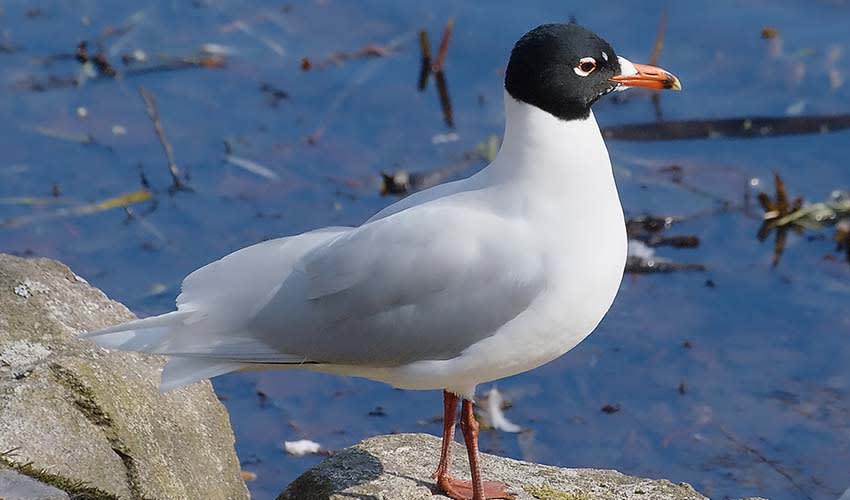A sleek, elegant gull best known for its jet-black breeding hood, bright coral-red bill, and crisp white wings that lack the dark wingtips many gulls show. It’s a bird that looks like it dressed in minimalist designer fashion — clean, bold contrasts with just the right splash of color. Native to southern Europe and the Black Sea region, the species has expanded its range impressively in recent decades, now breeding from Spain to Ukraine and wintering along warm coasts from the Mediterranean to the Black Sea, North Africa, and parts of the Middle East. Outside breeding season, it wanders widely, with increasing sightings in Western and Northern Europe, especially around Britain and the Netherlands.
One of the Mediterranean Gull’s most striking features is its pure white flight feathers, which create a smooth, unbroken wing surface. Combined with a rounded head and a slightly heavier red bill, the look is surprisingly refined compared to many gulls. In winter, the hood fades to a smudgy mask pattern, but the bird remains distinctive thanks to its pale grey mantle and almost porcelain-white body. Its call — a nasal, somewhat cat-like kreee-arr — can stand out among mixed gull flocks, especially when colonies get noisy during breeding season.
Feeding habits are flexible, with a diet that includes insects, marine invertebrates, small fish, worms, seeds, and occasionally human food scraps. In agricultural landscapes, they often hunt insects by following tractors — a behavior that has helped them thrive as farmland changes across Europe. During migration and winter, they gather in flocks on mudflats, beaches, and lagoons, often roosting in groups that combine adults and birds in various juvenile plumages, which can be a challenge even for experienced birders to sort through.
Distribution
 Albania
Albania Algeria
Algeria Austria
Austria Azerbaijan
Azerbaijan Belarus
Belarus Belgium
Belgium Bosnia And Herz.
Bosnia And Herz. Bulgaria
Bulgaria Croatia
Croatia Cyprus
Cyprus Czechia
Czechia Denmark
Denmark Egypt
Egypt Finland
Finland France
France Gambia
Gambia Georgia
Georgia Germany
Germany Gibraltar
Gibraltar Greece
Greece Hungary
Hungary Iran
Iran Iraq
Iraq Ireland
Ireland Israel
Israel Italy
Italy Kazakhstan
Kazakhstan Kenya
Kenya Kuwait
Kuwait Latvia
Latvia Lebanon
Lebanon Libya
Libya Malta
Malta Mauritania
Mauritania Monaco
Monaco Montenegro
Montenegro Morocco
Morocco Netherlands
Netherlands North Macedonia
North Macedonia Norway
Norway Poland
Poland Portugal
Portugal Romania
Romania Russia
Russia Saudi Arabia
Saudi Arabia Senegal
Senegal Serbia
Serbia Slovakia
Slovakia Slovenia
Slovenia Spain
Spain Sudan
Sudan Sweden
Sweden Switzerland
Switzerland Syria
Syria Tunisia
Tunisia Turkmenistan
Turkmenistan Turkey
Turkey UAE
UAE Ukraine
Ukraine United Kingdom
United KingdomAnything we've missed?
Help us improve this page by suggesting edits. Glory never dies!
Suggest an editGet to know me
Terrestrial / Aquatic
Altricial / Precocial
Polygamous / Monogamous
Dimorphic (size) / Monomorphic
Active: Diurnal / Nocturnal
Social behavior: Solitary / Pack / Colony
Diet: Carnivore / Herbivore / Omnivore / Piscivorous / Insectivore
Migratory: Yes / No
Domesticated: Yes / No
Dangerous: Yes / No




